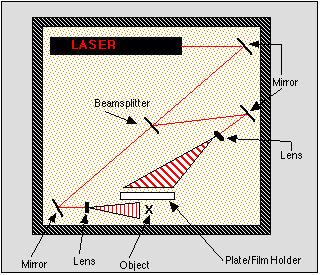
Holography, photographing in 3 Dimension
About Holography and the principles of Holography, lots of books have been written. The basic principles of classical Holography will shortly be explained on this page.
What is a hologram...
A hologram is a sort of a photograph of a 3-Dimensional object. But where a photograph only records an object in 2 dimension, a hologram records also the third dimension of an object. And where a photograph can be viewed almost anywhere, a hologram can be viewed only when the hologram is lighted under the correct angle with either a laser lightsource (master-holograms) or a Halogen lightsource (reflection holograms). Take a look at the page "holograms" or in the Shop to see some examples. (Be ware: a computer screen is a two-dimensional display. Therefor you will not be able to see the third dimension of the holograms shown on this page.)
How a hologram is made...
The making of a hologram can be divided into 2 procedures. The making of a master hologram and the making of a reflection hologram. They both have to be recorded in total darkness. The recording of holograms is a process sensible to vibrations. Let's start with the recording of a master hologram.
To record a master hologram, a few things are needed: an object, a holographic film, a beamsplitter and a laser. The lenses and mirrors needed to focus and lead the laserbeams will not be discussed here. The laserbeam is split into two beams using the beamsplitter. One beam is sent straight to the Holographic film, this beam is called the reference beam. The other beam, the object beam, is sent to the object, which is placed in front of the Holographic film. This will lead to 2 beams lighting the Holographic film from the same side. One beam straight from the laser source and the other reflected by the object. These 2 beams interfere with each other. Thus, an interference pattern is recorded on the Holographic film. After having developed the Holographic film, the obtained master hologram can be viewed by lighting the master hologram again with the reference beam under the same angle. The original object now can be seen through the master hologram.
The making of a reflection hologram does not differ very much from the making of a master hologram. The only substantial difference is where the light hits the Holographic film. The making of a master hologram required the lighting of the film from one side. The making of a reflection hologram requires the lighting of the Holographic film from both sides. So the reference beam will light the film from the front, and the object beam will light the film from the back side. Now a hologram is obtained that can be viewed best with a halogen lightsource or in sunlight. The hologram has to be lighted from above under an angle of 45 degrees. So, no laser needed here. Then why should you want to produce a master hologram, that can only be viewed under very difficult circumstances? The answer is rather shortly: because a master can be used, instead of an object, to record a reflection hologram. So once you have recorded a beauty of a master hologram, copies of it can easily be made. Besides, if you break a master hologram in two pieces, you get two identical smaller masters. Well, let us know if you manage to do that with a photograph.

The making of a reflection hologram
| Back to technologies | Next Technology |
© Dutch Holographic Laboratory